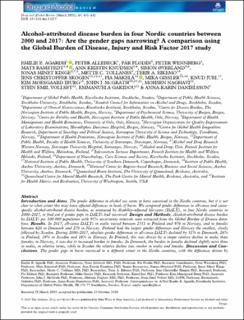Alcohol‐attributed disease burden in four Nordic countries between 2000 and 2017: Are the gender gaps narrowing? A comparison using the Global Burden of Disease, Injury and Risk Factor 2017 study
Agardh, Emilie, E.; Allebeck, Peter; Flodin, Pär; Wenneberg, Peter; Ramstedt, Mats; Knudsen, Ann Kristin; Øverland, Simon Nygaard; Kinge, Jonas Minet; Tollånes, Mette C.; Eikemo, Terje Andreas; Skogen, Jens Christoffer; Mäkelä, Pia; Gissler, Mika; Juel, Knud; Iburg, Kim Moesgaard; McGrath, John J.; Naghavi, Mohsen; Vollset, Stein Emil; Gakidou, Emmanuela; Danielsson, Anna-Karin
Journal article, Peer reviewed
Published version

Åpne
Permanent lenke
https://hdl.handle.net/11250/2740664Utgivelsesdato
2021Metadata
Vis full innførselSamlinger
Sammendrag
Introduction and Aims
The gender difference in alcohol use seems to have narrowed in the Nordic countries, but it is not clear to what extent this may have affected differences in levels of harm. We compared gender differences in all‐cause and cause‐specific alcohol‐attributed disease burden, as measured by disability‐adjusted life‐years (DALY), in four Nordic countries in 2000–2017, to find out if gender gaps in DALYs had narrowed.
Design and Methods
Alcohol‐attributed disease burden by DALYs per 100 000 population with 95% uncertainty intervals were extracted from the Global Burden of Disease database.
Results
In 2017, all‐cause DALYs in males varied between 2531 in Finland and 976 in Norway, and in females between 620 in Denmark and 270 in Norway. Finland had the largest gender differences and Norway the smallest, closely followed by Sweden. During 2000–2017, absolute gender differences in all‐cause DALYs declined by 31% in Denmark, 26% in Finland, 19% in Sweden and 18% in Norway. In Finland, this was driven by a larger relative decline in males than females; in Norway, it was due to increased burden in females. In Denmark, the burden in females declined slightly more than in males, in relative terms, while in Sweden the relative decline was similar in males and females.
Discussion and Conclusions
The gender gaps in harm narrowed to a different extent in the Nordic countries, with the differences driven by different conditions. Findings are informative about how inequality, policy and sociocultural differences affect levels of harm by gender.
